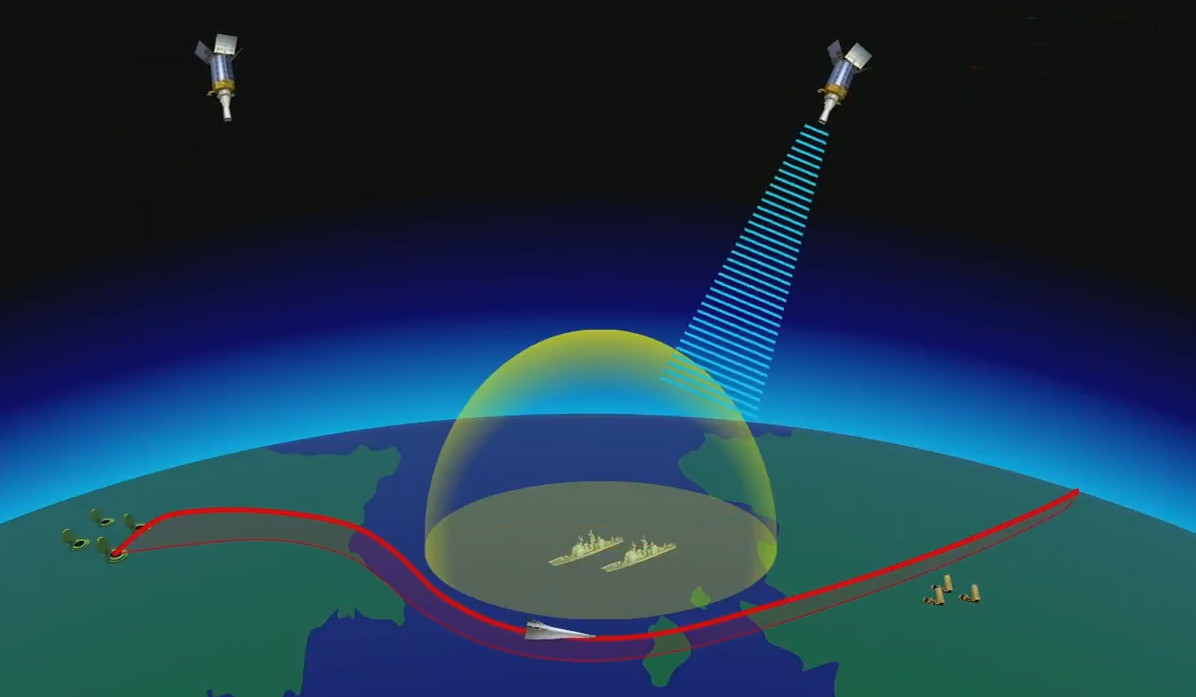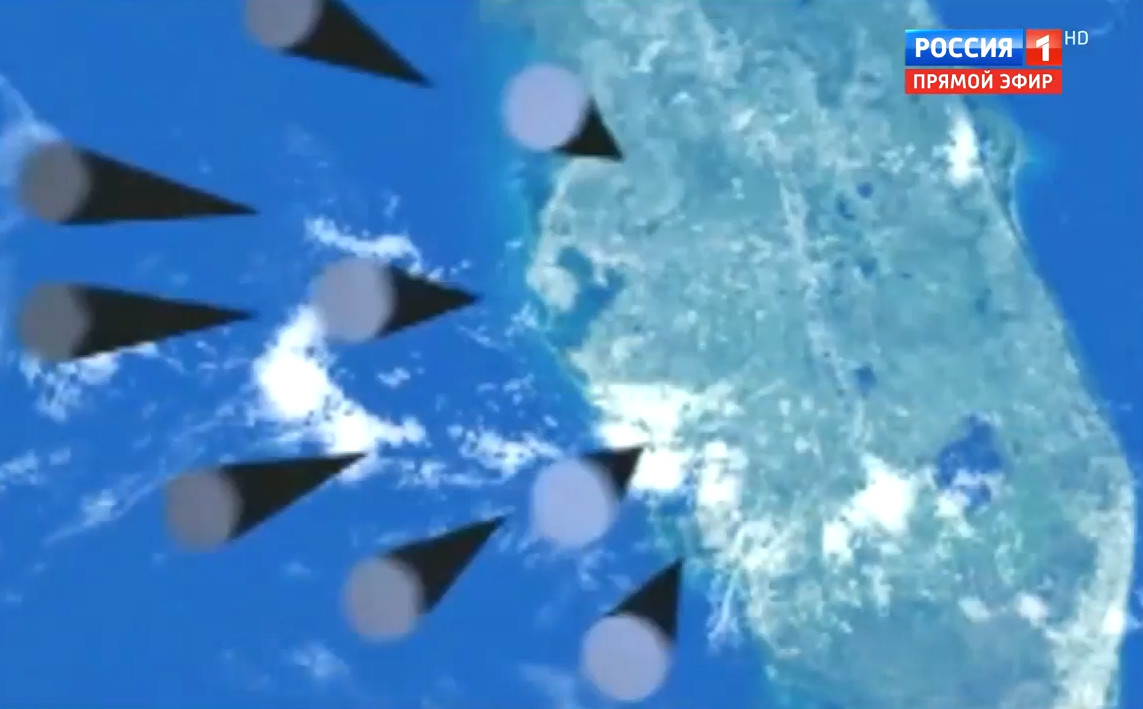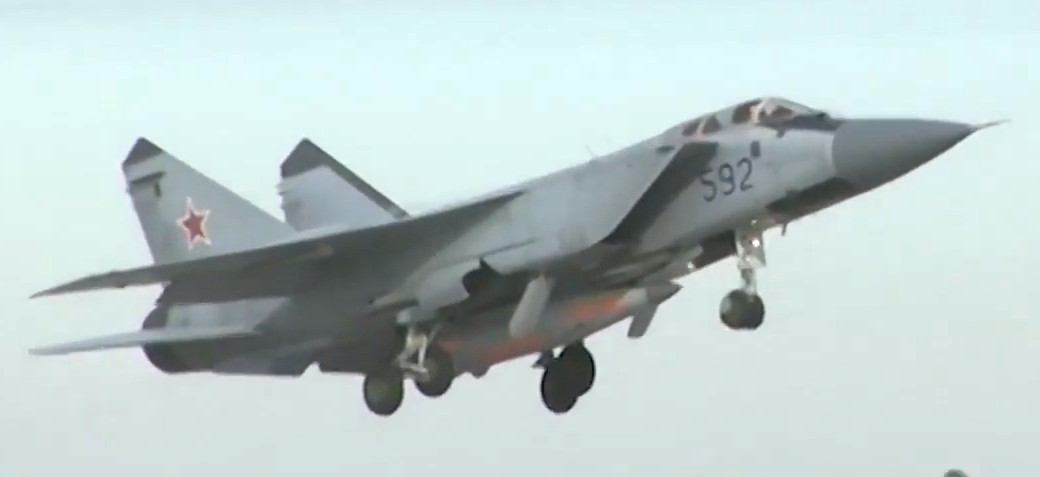In an impassioned state-of-nation address before Russian lawmakers and other senior government officials, accompanied by video footage and computer generated graphics, Russia’s President Vladimir has claimed his country is working on a host of new nuclear and other advanced weapons, including a nuclear-powered and nuclear-armed cruise missile with effectively unlimited range. These developments are ostensibly in response to American missile defense programs and can only further inflame already heightened tensions between the Kremlin and the U.S. government over various arms control agreements.
Putin made his remarks at the Manezh Central Exhibition Hall near the Kremlin on March 1, 2018. Some lawmakers smiled and cheered as he detailed the various weapon development programs. These included the cruise missile with a nuclear engine, as well as the publicly known RS-28 Sarmat intercontinental ballistic missile (ICBM), the previously unacknowledged nuclear-tipped Avangard hypersonic boost-glide vehicle and Kanyon or Status-6 nuclear-armed unmanned undersea vehicle, a possibly dual-purpose nuclear and conventional air-launched hypersonic cruise missile called Kinzhal, and a short-range directed-energy system visually similar to the U.S. Navy’s own AN/SEQ-3 Laser Weapon System.
“No one has listened to us,” Putin declared. “You listen to us now.”
A nuclear-powered cruise missile with unlimited range
The most eye-catching of the announcements is clearly the as yet unnamed nuclear-powered cruise missile. The basic concept is hardly new, but depending on how functional and reliable the final design might be, it could be a potentially game-changing development.
Though we don’t know how the Russians plan to configure this missile, in the 1960s, the U.S. Air Force explored a similar idea with the Supersonic Low Altitude Missile, or SLAM. This weapon employed a nuclear-powered ramjet along with conventional rocket boosters to kickstart the system. Once at the appropriate speed, the engine would blow air over the reactor, which could have enough fuel to operate for weeks or months on end, and then force it out of an exhaust nozzle to produce thrust.
In theory, this system allows for almost unlimited range. A computer generated graphic accompanying Putin’s announcement showed the missile plotting a course from Russia into the Atlantic, flying around South America’s Cape Horn, and then continuing on to strike what appeared to be a target in Hawaii.
Cruising at high speed on a circuitous route at extremely low altitude, the missile could potentially avoid surface- and space-based early warning systems and missile defense interceptors. With a two-way data link, operators could potentially modify its course in flight to further confuse an opponent or actively counter any attempts to shoot the weapon down. The American SLAM concept also involved a design carrying multiple nuclear warheads that it could drop on different targets along the way, but it is not clear whether the Russian system includes any features that allow it to strike at more than one location.

“No one in the world has anything like that,” Putin said. “It may appear someday, but by that time we will develop something new.”
The main problem with nuclear propulsion systems is safety and environmental hazards. To be small enough to reasonably fit inside a missile, the nuclear ramjet the United States developed for SLAM and other projects had no shielding to contain dangerous radiation. The exhaust plume also contained unspent fissile material that would have contaminated any area, enemy controlled or not, that it passed over on its way to the target.
Putin suggested tests of the propulsion system had occurred in 2017, but there was no indication of whether this had been in flight or on the ground and under what conditions. An actual, but grainy video accompanied this portion of his announcement, but it was unclear whether or not this was actually a prototype of the cruise missile.
Nuclear-armed Hypersonic boost glide vehicles
In addition, the Russian president publicly unveiled a nuclear hypersonic boost glide vehicle called Avangard, which he said would go on the future RS-26 Rubezh ICBM. Weapons of this type follow a very different flight trajectory within the atmosphere, can make rapid course changes, and have different signatures compared to traditional ICBMs, which could make them harder for sensors and defense systems to spot and engage.
Their speed, faster than Mach 6, means an enemy has dramatically less time to react than with conventional inter-atmospheric craft, that is even if they do detect the incoming weapon at all. Putin said Avangard can reach speeds up to 20 times the speed of sound, hitting its targets “like a meteorite, like a fireball.”

This makes these systems ideal for no- or short-notice strikes against critical items, such as enemy strategic capabilities, air and missile defenses, and command and control facilities, as well as potentially fleeting targets, including military or civilian leadership. In September 2017, the Russians said they had tested an RS-12M Topol missile with an “advanced combat payload,” which could have been an Avangard prototype, and you can read more broadly about the potential capabilities of such a weapon here.
A more capable heavy ICBM
This hypersonic boost vehicle has also long been among the many rumored capabilities of the up-coming RS-28 Sarmat ICBM, which has been publicly in development since 2014 and the Russians expect it to enter service by 2021. This system, which NATO also calls the SS-X-30 Satan 2, will replace the older R-36M or SS-18 Satan as Russia’s primary silo-based ICBM.
The RS-28 is reportedly significant faster than the older R-36M and will carry multiple warheads of some form, each capable of independent movement. Beyond the possible use of hypersonic boost glide vehicle warheads, other reports have suggested it might have a fractional orbital bombardment capability, in which the re-entry vehicles enter low earth orbit briefly and “go cold,” making it hard to track their onward progress before they come hurtling down on a target.
Another possibility is an independent post-boost vehicle (IPBV) arrangement, which Russia may have tested in October 2017 on an existing RS-24 Yars ICBM and which you can read about more in detail here. Whatever the case, the computer generated depiction of Sarmat menacingly showed a number of independent warheads falling onto Florida.

A nuclear-armed underwater drone
In addition, Putin publicly announced Russia has been working on a nuclear-armed unmanned undersea vehicle. There have been a number of reports of both of these weapons being in development for years, but without any clear official confirmation. The craft, which Putin says has no official name as yet, but which observers have referred to as Kanyon and Status-6 since information about the system first leaked out in 2015, is a completely different approach to avoiding missile defenses.
Launched from a submarine well off shore, the underwater drone then makes it ways to the target area, avoiding any sensor networks or other defenses, before detonating its reportedly dirty warhead, causing significant immediate damage and lasting contamination. A computer generated presentation about the vehicle shows a modified Oscar II class submarine carrying a pair of the unmanned submarines in a special forward compartment.
Putin suggest the drone would be “100 times smaller” than traditional submarines and therefore be especially difficult to detect. It would also be able to travel at “extreme depths” and at speeds that “greatly exceeds the speed of all submarines, up-to-date torpedoes and all types of high-speed surface ships,” making it even harder for an opponent to spot and intercept it before it reached the target area.

Previous reports, as well as accompanying video, suggest the weapons are large, though, which might necessitate a new, specialized mothership. The same video presentation paired with Putin’s discussion of this system appeared to show a more conventional torpedo, but its not clear if this is supposed to be stand-in for the nuclear-armed drone or if that craft might launch those weapons itself once it gets closer to the target.
There is the suggestion that this unmanned undersea vehicle may have a nuclear powerplant, as well, which could conceivably allow submarine carrying it to launch it from almost anywhere in the world. The Russians appear to envision the system as a means of targeting task forces of surface warships – all of the computer-generated examples were clearly based on American designs – including aircraft carrier strike groups, as well as naval bases and ports.

Hypersonic cruise missiles and lasers
The last missile system that Putin disclosed was the Kinzhal air-launched hypersonic missile, which a video showed a MiG-31 Foxhound interceptor carrying aloft and releasing. It is not clear whether or not that jet is the primary launch platform or if this system is nuclear capable. It reportedly has a range of approximately 1,250 miles and a top speed of more than 10 times the speed of sound. According to the Russian president, units in the country’s Southern Military District, which borders Ukraine and the Black Sea, have deployed the missiles operationally.
Russia had previously claimed it was working on a hypersonic anti-ship missile called Zircon and computer generated graphics during Putin’s speech showed Kinzhal attacking surface warships, though it also reportedly has a land-attack capability. It’s unclear how the two weapons might be related, if at all, but Kinzhal could simply be an air-launched derivative of the sea-launched Zircon.

In general, these types of weapons typically use a rocket motor to kickstart an air-breathing engine of some kind to push them to at least Mach 6, making them harder for existing land- and space-based sensors to spot. Already capable of potentially making rapid course corrections and otherwise flying erratically, the weapon’s speed could make it very difficult for most existing surface- and airborne radars to track in order to cue an interceptor or other close-in defense system.
As with the hypersonic boost glide vehicles, this means these missiles could be a game-changing capability, giving Russian jets the ability to launch no- or short-notice strikes at long distance against enemy ships or land-based targets. In what appears to be its primary role, it would be a major threat to American aircraft carriers or other warships, which do not have any defenses against such a weapon at present. And again, this capability would be perfect for hitting time-sensitive targets, letting the Kremlin shrinking the time it takes to turn actionable intelligence into an actual response and strike its opponents before they can move to another, possibly less vulnerable location.
Coming after all of these systems, the truck-mounted laser cannon looks far less impressive, but its still an important development. As a point defense system, this directed energy weapon could be helpful for defeating various existing and emerging threats, particularly small drones.
Earlier in the year, Russian bases in Syria found themselves on the receiving end of mass drone attacks, which is exactly the kind of scenario in which a mobile laser might be an valuable addition to other air defense and electronic warfare systems. It’s an indication that Russia is actually investing its limited resources in advancing its capability in this area, as well, even if recent reports of a work on a new anti-satellite laser system fitted on a still notional high-altitude aircraft sound particularly fanciful.

A display of Russian strength
“I want to tell all those who have fueled the arms race over the last 15 years, sought to win unilateral advantages over Russia, introduced unlawful sanctions aimed to contain our country’s development: all what you wanted to impede with your policies have already happened,” Putin said in his March 2018 speech. “You have failed to contain Russia.”
The “unilateral advantages” Putin was referring to are almost certainly the U.S. military’s missile defense programs, which include basing Aegis Ashore ground-launched ballistic missile interceptor sites in Europe. The United States has repeatedly denied that any part of its ballistic missile defense shield presents a challenge to the deterrent capabilities of large nuclear powers, such as Russia or China, and that they are instead focused on defending against smaller actors, such as North Korea and Iran. Whatever the intent, American ballistic missile defense shield is simply not capable of negating Russia’s nuclear deterrent.
The “unlawful sanctions” in question are the economic restrictions the United States and other countries, especially in Western Europe, imposed on Russia in the wake of its unilateral and illegal annexation of Ukraine’s Crimea region. The U.S. government in particular has expanded those measures in response to Russian involvement in the simmering conflict in Ukraine’s eastern Donbass region, its support for Syria’s brutal dictator Bashar Al Assad, and its interference in the 2016 American presidential election.
The United States and Russia have increasingly sparred over these issues, which has had a cascading impact on various arms control agreements, which we at The War Zone have examined in depth on multiple occasions. The two countries have been locked particularly tense rhetoric over the Intermediate-Range Nuclear Forces Treaty, or INF, which limits the kind of land-based missiles, nuclear or otherwise, that both sides can develop and put into service.

You can watch a full video of Putin’s speech, in Russian, but which also shows the various accompanying media, below.

Tensions with the United States
It is well understood that Russia is in violation of the INF, while the Kremlin says the U.S. military has been working toward the same end with its land-based missile launchers in Poland and Romania. Putin notably did not mention the SSC-8 ground-launched nuclear cruise missile, which the United States says violates the terms of the INF, but which the Kremlin has never publicly acknowledged as existing at all.
Now the United States has publicly threatened its own treaty-breaking missile development in response and included plans for a new sea-launched nuclear cruise missile with a low-yield nuclear warhead in its latest Nuclear Posture Review (NRP). Senior U.S. officials, including Secretary of Defense James Mattis, have suggested an offer to abandon this development program might be a useful bargaining chip in future arms control negotiations.
“We will interpret any use of nuclear weapons against Russia and its allies no matter how powerful they are, of low, medium or any other yield, as a nuclear attack,” Putin said, directly responding to the NPR’s proposed development of more “flexible” low-yield nuclear weapons. “It will trigger an immediate answer with all the consequences stemming from it. No one should have any doubts about it.”
This flurry of new missile developments could easily change the calculus again. There are already reports that a forthcoming U.S. military review of its missile defense posture might make it official policy that those systems are, in fact, targeted, at least in part, at Russia and China.
Speaking after the event, Russian Defense Minister Sergei Shoigu implied that American allies, both in Europe and Asia, and possibly elsewhere, should be reconsidering whether they want to invest in American-made missile defenses. “I don’t know why they would now buy such an ‘umbrella’ [that is full of holes],” Shoigu said, specifically in reference to South Korean and Japanese missile defense plans.

There is, as always, an important question about whether or not Russia and its fluctuating economy can sustain the development of these various advanced weapon systems. Sanctions and a continued slump in the global price of oil already forced the country to make significant cuts to defense spending in 2017, including cancelling plans to reboot its train-mounted IBCM program.
It’s also not clear how much of Putin’s charged rhetoric is driven by the fact that he is running for re-election as Russia’s president. Though experts and observers widely believe he will easily win in a less than free and fair election in later in March 2018, opposition politicians and political groups have launched significant protests and continue to challenge and criticize his leadership.
“You will have to assess that new reality and become convinced that what I was said today isn’t a bluff,” Putin noted. “It’s not a bluff, you trust me.”
It remains to be seen just how far Russia proceeds with the various projects, especially the nuclear-powered cruise missile. It’s reasonable to be skeptical that Russia has the resources to follow through with its plans, but even if only one or two of these systems come to fruition, they could be immensely destabilizing.
If nothing else, the announcements are another worrying indicator Russia’s increasingly assertive foreign policy and growing tensions between the Kremlin and the U.S. government.
Contact the author: joe@thedrive.com
